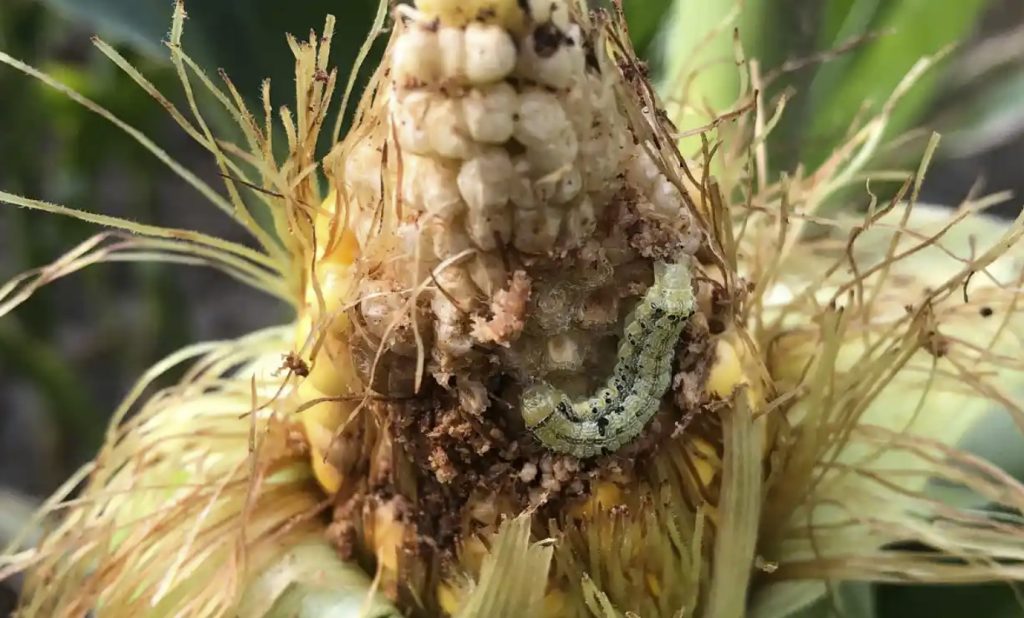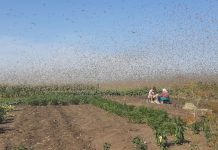
Agricultural pests that devour key food crops are advancing northwards in the US and becoming more widespread as the temperature heats up, new research warns.
The corn earworm (Helicoverpa zea) is considered to be among the most common farm pests in the US, ravaging crops such as maize, cotton, soya and other vegetables. It spends winter underground and is not known to survive in states beyond a latitude of 40 degrees north (which runs from northern California through the midwest to New Jersey), but that is changing as soils warm and it spreads to new areas, according to research led by North Carolina State University.
Protect your home and cars againts EMP, solar flare and lightnings…
The report follows research from the University of Washington in 2018 that found 2C (3.6F) of warming would boost the number and appetite of insects globally, causing them to destroy 50% more wheat and 30% more maize than they do now. Rising heat stress is already affecting yields, with harvests of staple crops in Europe down this year as a result of heatwaves and drought.
Pest invasions have serious implications for food security. “As the climate changes, the overwintering zones are likely to shift northward,” said the co-author Anders Huseth, an entomologist at North Carolina State University.
This is the canary in the coalmine for agricultural pests
“Making sense of what’s taking place with [the corn earworm] is really important for agricultural producers.” Other pests that could spread northwards in the US in a similar way include fall armyworm, green cloverworm, soybean looper and velvetbean caterpillar.
You will never go without electricity with this portable power station!
Researchers created maps that showed three distinct geographical zones across the US – the “southern range” where corn earworms survive winter, a “transitional zone” where they may survive winter, and “northern limits”, where they are generally unable to survive winter because soil temperatures drop below freezing.

Researchers already knew that warmer winter soils meant insects that live in the soil are more likely to survive. Using four decades of soil temperatures and data monitoring corn earworm, researchers predicted the distribution of pests in the future.
The southern range has grown by 3% since 1981 and is predicted to double in size by the end of the century, as the other zones get smaller, according to the paper, published in Proceedings of the National Academy of Sciences. Corn earworm moths are able to disperse up to 600 miles (1,000km) using seasonal winds, meaning they can spread fast if conditions are good.
Over the coming decades the model illustrates that this insect could expand its overwintering range into the US maize belt in Ohio, Indiana, Illinois, Missouri and Iowa. In Minnesota, for example, no corn earworms have successfully survived its harsh winters, but the models suggest the whole state will be in the transitional zone by the end of the century.
Increased use of pesticides and lower yields
This could result in increased use of pesticides and lower yields. “If intensive maize production does not also shift north with changing climate, we expect that corn earworm will become a more frequent and important problem in these states,” said Dr Douglas Lawton, a former North Carolina State University postdoctoral researcher and co-author of the paper.
Drink SAFE water at home. That’s the best filter around…
“Organic growers have a major challenge controlling this pest and often accept significant crop losses when infestations are high,” he said.
Monitoring soil temperatures could help predict the spread of pests, helping farmers control them more effectively, the report suggests. Huseth said: “We’d like to come up with a better forecasting tool for this pest, along with a risk-prediction model, in order to give growers better information about pest spread. Success here could reduce both costs for farmers and pesticide into the environment.” [PNAS, Guardian]













The author thinks the corn earworms could survive a winter in Minnesota. lolollolllollllolllll —my ass.
He needs to watch the ground freeze in Minnesota. Thinking he drinks the globull warming kool-aid too much.
Soon the locust, mites, beetles, mice, rats, etc., will all return in droves and there goes the bread.
Ratty,
I switched off bread in my diet. There’s crap in bread now that wasn’t there 50 years ago. Convinced bread makes people fat, pre-diabetic, and lethargic. Rice and legumes/beans digest better for me. Keep the beans down to two table spoons, or the digestion isn’t so great. Dried apricots and dried dates are good for quick carbs. So are grapes. Just 2 or 3 (dried fruits) grapes about 25 is right. Not a pile of ’em.
I guess that’s why a thousand years ago, when the climate was so much warmer, the Norwegians grew crops in Greenland (why its called “Greenland’) and grapes grew in Sweden. Then the “Little Ice Age” came…from which we are still (and almost) returning to “normal.”
Some bacteria/virus remain dormant in soil too. Be interesting to see if rising soil temperatures reanimate dormant bacteria/virus. My old veterinarian once told me that Valley Fever is in the soil here. Maybe it was another type of disease, as it was over two decades ago.
As far as crops go, you can protect trees against parasitic bugs. Beetles, moth larvae, aphids, scale bugs, hornworms. I don’t like spraying poisons, but sometimes I have to. Seven, Malathion, Fertilone Root Drench are among the products I have used successfully. Up in my orchard all my young peach trees acquired scale bugs. Also a wood boring insect. I pulled ’em, and burned ’em. $250 loss. Except the tree seller did give me a good discount on my apricot trees to be a good sport, since it may have happened on his facility.
Poor Rus, When you harm others, you just harm yourself and when you imprison others, you imprison yourself! After all these years and never learned, what will the guy upstairs do to you…The Rus in me is ashamed?
Camshaft,
Don’t feel guilty. Russia not the one harming people. I know this conflicts with reports from the MSM but seems to me they lie pretty much 100% of the time. And reports indicate that woman doper, is actually a man. Weird times.
It will get colder as far as winters go, as that underwater volcano spewed materials very high up, and according to electroverse.co, we will have colder winter seasons coming up. Similar to the 1991 volcano in the Philippines.
Livestock eat alot of corn. So if this article here is correct, then supply will diminish, and demand will remain strong. Look for corn feed prices to increase. The eggs, chicken, pork, and anything that eats corn feed will be much higher cost to the end used.
We get the big green hornworm caterpillars. Those bastards can strip a young tree right before your eyes. Those enormous gypsy moths(look very pretty like a butterfly) lay eggs on your tree leaves, and when they hatch you can’t see them, but as they move up your tree they grow huge. They are eating machines. I feed those green hornworms to my ducks and roosters. I had a 7′ cherry tree get stripped, but I coddled it, and it came back stronger. That’s rare though. Sometimes they stunt a tree, and it takes a year for it to come back. They hide under the leaves and camouflage themselves. On young trees, (during season) if I see leaf loss, I shake the young tree vigorously. The hornworms will fly off and hit the dirt. Then the roosters, ducks, and hens will have a feeding frenzy. Pestilences and famines are heading our way. There are Biblical examples of this too.
Your green horn worms aren’t the same as ours.Ours are better known as the tobacco worm aka tomato hornworm.Ours don’t usually attack trees.They will however devastate tomato plants.Surprisingly most adult plants survive but look weird.Usually I clip the devastating branches.Makes it less appealing to the critters and helps the plant bounce back.
Sometimes a change in planting times can help.So can avoiding a second summer planting.This helps to stop the second generation bugs.
grass fed don’t eat corn
Yeah, I know. Cattle here eat grasses. So do most grazing creatures. Commercial livestock go through corn and barley though.
GAS
Yahoo
/
Sent
james camarata
To:
Prepping Info
Wed, Sep 7 at 3:02 AM
Hi Steve More Good Shows, Thanks! How is it that there is a supposed war in Ukraine, but gas pipelines, oil depots and power plants are off limits…Sure? Are there interests around the globe that would like to see those pipelines blown up? Pipelines got to be one of the easiest things to blow up? Besides, who is Russia going to sell it’s oil and gas to using pipelines? Not China, constantly locked down, no factories running and the people on the verge of revolution? Not India, goes by boat? Lots of greedy oil companies would like to see those pipelines go…more profit and power for them? The Middle East would like to see them go? Doesn’t look like Russia’s pipelines are really worth a shit? Russia should stop using woman as political pawns and empty, worthless pipelines as tools of war? Your gunna lose as the world’s people adapt, quickly? What happens when a nuclear plant starts leaking with the wind blowing the right direction, Russian army goes home fast! Looks like a no win situation for all the Rus?
Blackouts in cali don’t include military bases and gov’t buildings/offices…they use the most and should be cut first…I thought this was a democracy? looks like the serfs are the ones that pay…while the lords and ladies eat cake?
Very good site, Thanks!
Articles with no base in reality, quoting unknown “researchers” previsions about the future that contradict known specialists on the present evolution of the planet. This days science is out for sale for the hysteria selling billionaires that told us 20 years ago the life will be gone on this planet in 10 years. They cannot predict the next 2 years but they come up with maps of 2099. You need to live under a rock in a CNN cave and be quadruple vaccinated to believe it.
Easy there Mary! You seem constipated my darling. Take in some more fiber and don’t strain so much.
Rice and black beans (not too much)and a couple of dried fruit pieces. Boom, done deal— all your troubles go down the drain. Hahahaa